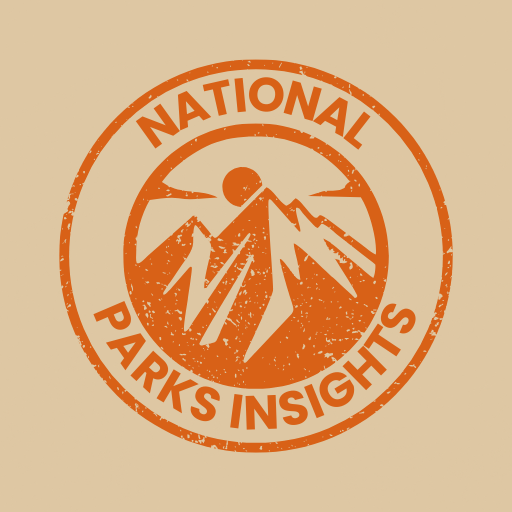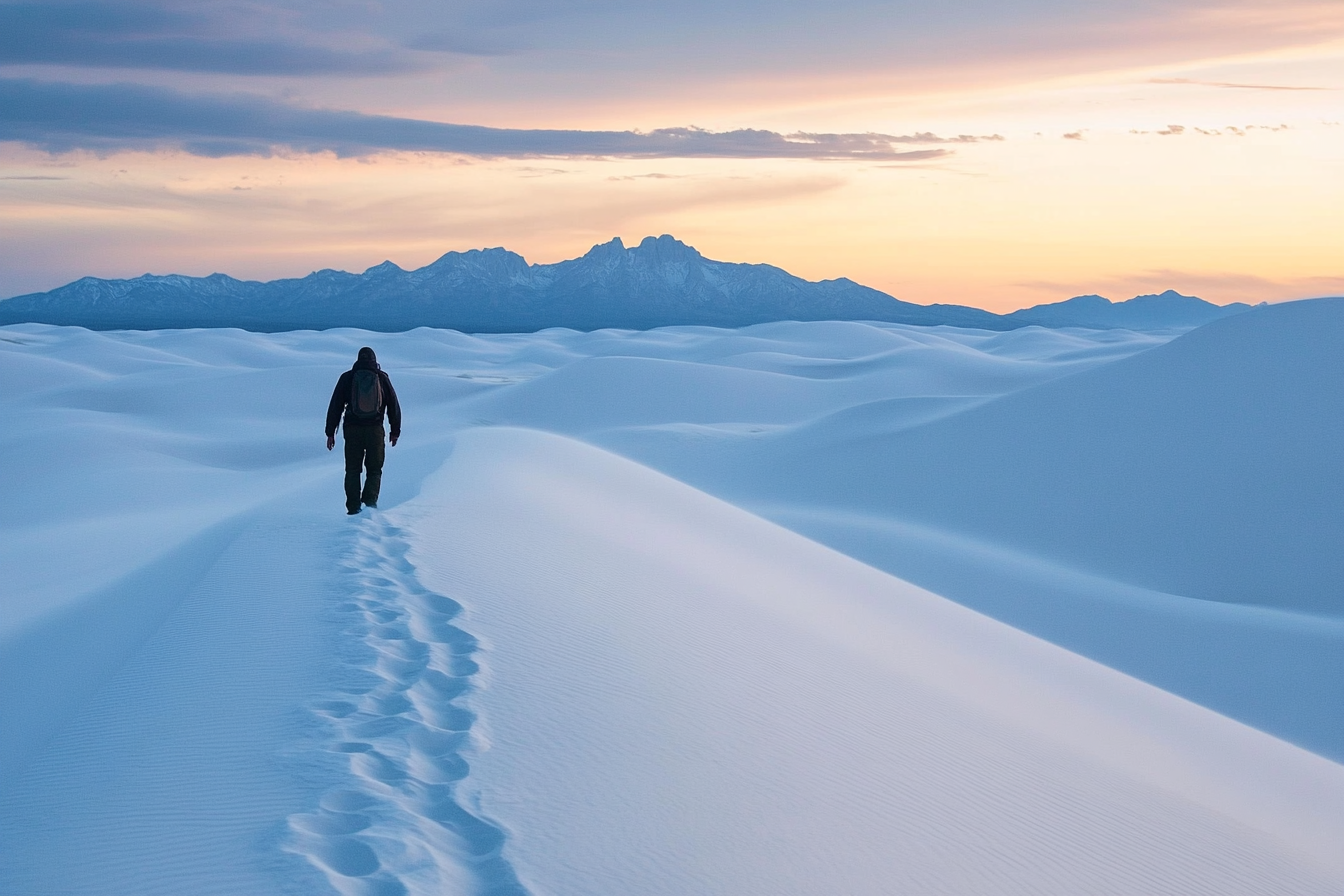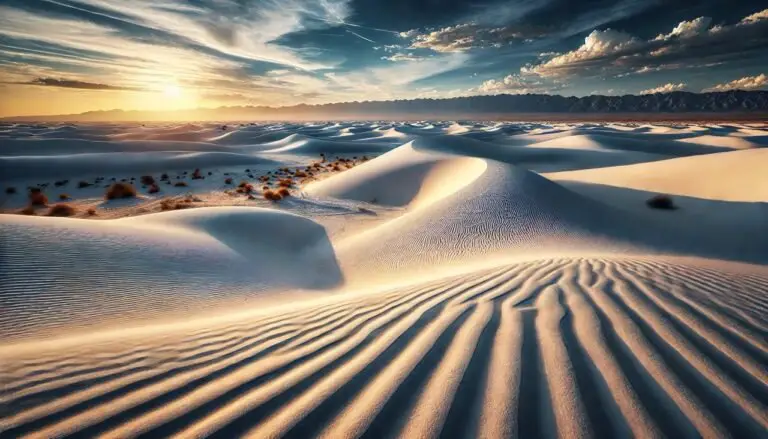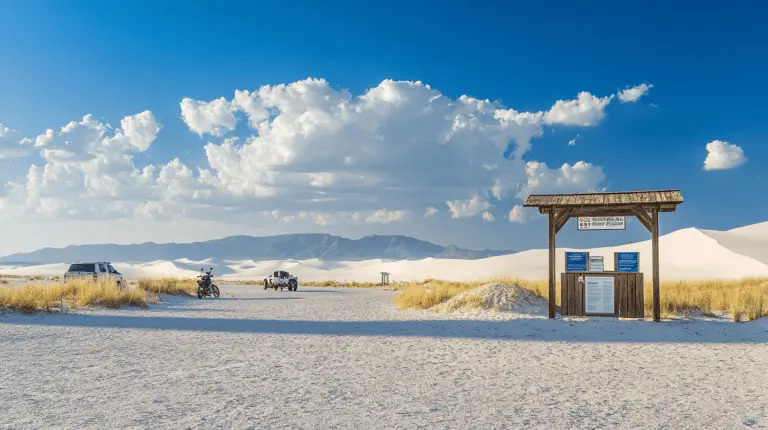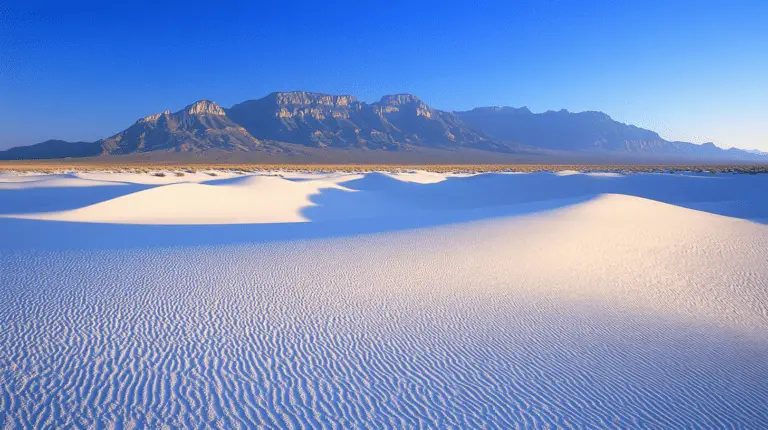Check Out White Sands National Park
Gypsum Dunes Like No Other
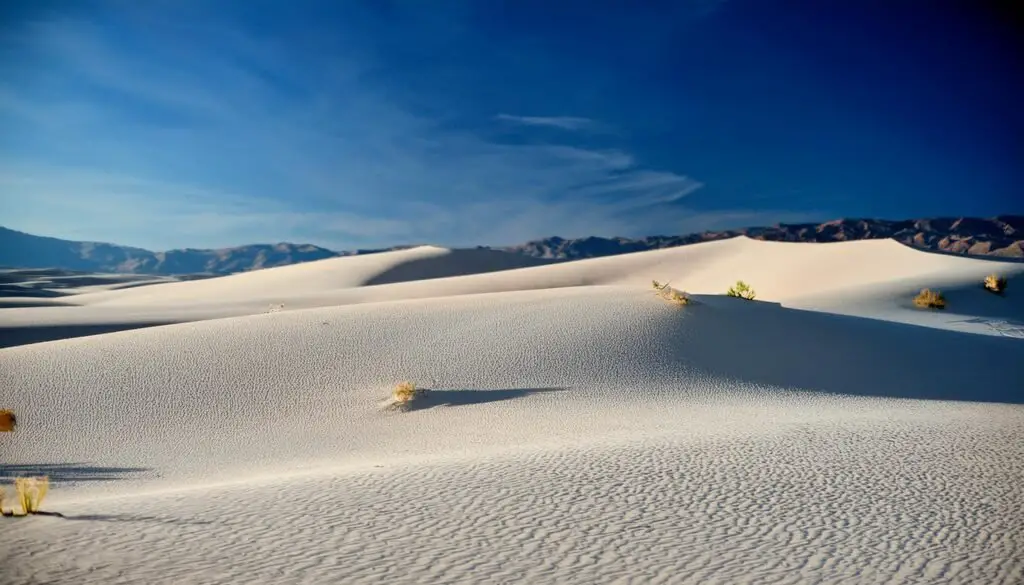
White Sands National Park isn’t just any park – it’s 275 square miles of super white sand dunes made from gypsum. Imagine walking on bright, soft white sand that stretches as far as the eye can see! You might think you’ve landed on another planet. The wild white color here comes from gypsum, a mineral that forms these unreal dunes.
Wind constantly reshapes these dunes, and you can see them shifting several feet on a windy day. This ever-changing sandscape offers loads of fun. Hiking feels like a dream, and sand sledding – way cooler than regular sledding – is a must-try. Experience it all when you wander through White Sands dunes – trust me, you don’t want to miss this.
How White Sands Came To Be
Wondering how these mind-blowing dunes formed? Get ready for a story 250 million years in the making. Back then, the Tularosa Basin was underwater. Over time, gypsum from the sea settled and turned to rock. Fast forward to when the climate got hotter and drier, say about 10,000 years ago, and things changed big time.
Old Lake Otero dried up, leaving behind gypsum-covered flats and Lake Lucero. With winds whipping across at 17 mph, pieces of gypsum broke down into tiny grains, giving us the stunning White Sands today (NPS – Geology of White Sands).
Gypsum Dunes On The Move
| Stat | Detail |
|---|---|
| Coverage | 275 sq miles |
| Average Wind Speed | 17 mph |
| Dune Movement | Up to several feet per day |
The forces shaping this place are amazing. From the fragile beauty to the tough landscape, it’s a real treat for nature lovers. Want more details? Dig into our White Sands National Park geology page.
Before you go, don’t forget to check out the latest White Sands National Park weather – weather can change quickly in the desert! Pack your essentials, and get ready to be wowed by White Sands National Park.
Thinking about joining a White Sands National Park tour or curious about the park’s storied past? Check out our White Sands National Park history for more. Each visit promises an adventure you’ll never forget.
Visitor Information

Thinking about heading to White Sands National Park? Here’s what you need to know to make your visit fantastic!
Go Green, Stay Clean
White Sands National Park is all about keeping its beautiful environment pristine. Here’s how you can pitch in:
- Use the vault toilets scattered around the park.
- Bring refillable water bottles and reusable bags; leave single-use stuff behind.
- Pack out all your trash for a zero-waste picnic.
- Bring some extra bags for trash and recycling.
- Save water and energy while you’re there.
- Check out more tips from the National Park Service.
Follow these steps to enjoy those stunning white sands dunes while keeping nature happy.
Park Closures and Updates
Sometimes the road into White Sands National Park shuts down because of missile tests at the nearby White Sands Missile Range. Check for the latest road and park closure info before you head out to dodge any hiccups. Get the latest updates on the National Park Service’s website for White Sands.
| Area | Status | Notes |
|---|---|---|
| Entrance Road | Open/Closed | Check daily updates |
| Visitor Center | Open | Hours vary |
| Hiking Trails | Open | Check trail conditions |
For more, visit our page on White Sands National Park hours.
Ranger-Led Programs

Dive into the cool stuff White Sands National Park offers through ranger-led programs. They’re fun, educational, and let you really soak in the park’s awesomeness. From guided hikes to stargazing nights, there’s a bit of everything for everyone!
| Program | Description | Availability |
|---|---|---|
| Guided Hikes | Learn about the park’s geology and plants | Year-round |
| Evening Stargazing | Check out the night sky | Seasonal |
| Junior Ranger Program | Fun for kids | Year-round |
Find the current schedule and more info on the White Sands National Park website.
For more tips, info on maps, entrance fees, and all that good stuff, check out our pages on White Sands National Park map and White Sands National Park entrance fee. Have a blast and make some unforgettable memories!
Park Rules – Keepin’ It Real
Planning a trip to White Sands National Park? Awesome! But before you head out, let’s make sure you’re clued in on the park rules. Here’s the lowdown:
What Not to Do
To keep the park lookin’ sharp, there are some no-nos you need to know. Don’t even think about snagging sand or other goodies. Get caught, and you could face a hefty $5,000 fine or up to 6 months in the slammer (NPS – White Sands National Park).
Here’s the no-go list:
- No taking sand or other natural stuff
- No trashing the place
- Hands off the wildlife
- No off-roading outside marked paths
Wanna know more? Check out our park rules page.
Booze Rules
If you’re thinking about crackin’ open a cold one, there are some guidelines. Between February 1st and May 31st, you can only drink in certain spots:
- Yucca Picnic Area
- Road Runner Picnic Area
- Primrose Picnic Area
- Group Use Area
During park events, you can also drink in the Evening Program Area. Always check which areas and dates allow booze to avoid any hiccups.
| Spot | Drink Allowed (Feb 1 – May 31) |
|---|---|
| Yucca Picnic Area | Yes |
| Road Runner Picnic Area | Yes |
| Primrose Picnic Area | Yes |
| Group Use Area | Yes |
| Evening Program Area | Only during Events |
More deets? Hit our booze policy page.
Camping and Munching
White Sands National Park has you covered with a mix of both roughin’ it and modern comforts. Food spots might be scarce in the park, so plan ahead.
Camping Choices:
- Roughing it in the park
- Car spots and RV sites nearby
- Hotels and motels around town
For booking info, swing by our camping page.
Food Stops:
- Limited munchies in the park
- Restaurants in nearby Alamogordo
Make sure to plan meals and places to crash ahead of time to avoid any hangry moments. A list of good eats? Check out our Alamogordo guide.
Stick to these rules and help keep the park pristine. For more tips and the latest updates, click here. And remember, have fun out there!
Geology and History
How The Magic Happened
White Sands National Park isn’t just any stretch of sand; it’s a natural wonder where every grain tells a story. Imagine this: a massive sea around 250 million years ago, during what’s called the Permian era, left behind tons of gypsum. Now, gypsum usually forms big, chunky deposits, but here, they’ve turned into sparkling white sands that make the park so unique. This sea eventually vanished, but its legacy stayed, creating the striking dunefields you see today.
| Quick Facts | Amazing Details |
|---|---|
| Age of Gypsum Deposits | 250 million years |
| Formation Period | Permian era |
| Dunefield’s Start | 10,000 years ago to now |
| Gypsum Magic | Calcium sulfate dihydrate |
As the world got hotter and dryer, turning this area into the Chihuahuan Desert, winds carried the gypsum sands here and there, making them smaller and smaller. Whenever the breeze took a break, the gypsum would settle, just chilling out until the next gust came along.
Footprints from the Past
Now, let’s take a step back in time—literally. Ancient human footprints found in these sands offer a peek into the past. Thousands of years ago, people roamed this area, leaving their mark. These preserved footprints give us cool clues about how early humans lived and moved around, letting you almost walk in their shoes. Pretty wild, huh?
From Plain to Fame
Flash forward to December 20, 2019, when White Sands leveled up to become a national park. And wow, it caught on fast! By 2023, it was already pulling in 730,000 visitors (Earth Trekkers).
Over the years, White Sands has added facilities and services to make your visit a blast while keeping its natural beauty intact. Whether it’s ranger-led tours or eco-friendly practices, the park’s got you covered. The staff work their magic behind the scenes to make sure you have an awesome and informative time without messing up the environment.
Want to dig deeper into how this amazing place became a national icon? Check out our detailed page on White Sands National Park history.
And if you’re looking to stretch your legs or set up camp under the stars, don’t miss our guides on White Sands hiking trails and White Sands camping.
Beyond the Dunes
White Sands National Park isn’t just about dazzling white dunes stretching as far as the eye can see. Take a step beyond that sea of white, and you’ll uncover the dynamic story and natural wonders of the Tularosa Basin, along with some cool nearby hotspots.
Tularosa Basin: More Than Meets the Eye
Dive into the heart of the Tularosa Basin where you’ll find a pretty amazing geological story. Picture this: About 250 million years ago, during the Permian era, the gypsum that makes up these dunes started its journey (NM Bureau of Geology & Mineral Resources). Over eons, these marine deposits turned into stone, and voila, you’ve got the sparkling white sands we love today.
But wait, the show’s not over! About 10 million years ago, the Tularosa Basin decided to do some heavy lifting, pushing up to form the Sacramento Mountains on one side and the San Andres Mountains on the other (NM Bureau of Geology & Mineral Resources).
One of nature’s backstage acts is Lake Lucero. When this lake gets swamped by runoff from the San Andres Mountains during summer storm shows, it eventually evaporates. What’s left behind? Gypsum crystals. These crystals get carried by the wind across the park, sculpting those mesmerizing dunes.
Curious about more rock talk? Check out the geology of White Sands National Park.
Local Gems and Activities
Once you’ve had your fill of the dunes, there’s plenty more to discover nearby. Here’s your local travel hitlist:
- Alamogordo: Just a hop away, this place is packed with attractions like Space Harbor and the New Mexico Museum of Space History. Nerd out or just soak up the sights.
- White Sands Missile Range: North of the park lies a historic playground for missile and aerospace tech. Swing by their museum for a blast from the past (White Sands Missile Range).
- Tularosa Village: Historic charm, unique shops, and mouthwatering local eats make this village a must-visit. Perfect for soaking up some authentic culture.
- Organ Mountains-Desert Peaks National Monument: This spot’s got everything—breathtaking views, hiking trails, rock climbing, and plenty of wildlife. Lace up those hiking boots!
- Carlsbad Caverns National Park: A bit further east, but totally worth it. These limestone caves, especially the famed Carlsbad Cavern, are simply stunning.
For all the deets on local spots, hit up our nearby attractions guide. Before packing your bags, check out latest weather updates to make sure you’re all set.
White Sands National Park’s mix of rich history and unique geological charm make it a spot unlike any other. So go beyond the dunes and discover all the magical moments waiting for you.
